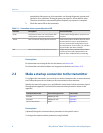
Immediately after power-up, the transmitter runs through diagnostic routines and
checks for error conditions. During the power-up sequence, Alarm A009 is active.
This alarm should clear automatically when the power-up sequence is complete.
2. Check the status LED on the transmitter.
Transmitter status reported by status LEDTable 2-1:
LED state Description Recommendation
Green No alarms are active. You can continue with
configuration or process measurement.
Continue with configuration or process meas-
urement.
Yellow One or more low-severity alarms are active. A low-severity alarm condition does not affect
measurement accuracy or output behavior.
You can continue with configuration or proc-
ess measurement. If you choose, you can iden-
tify and resolve the alarm condition.
Red One or more high-severity alarms are active. A high-severity alarm condition affects meas-
urement accuracy and output behavior. Re-
solve the alarm condition before continuing.
Postrequisites
For information on viewing the list of active alarms, see Section 8.4.
For information on individual alarms and suggested resolutions, see Section 10.2.
2.3 Make a startup connection to the transmitter
To configure the transmitter, you must have an active connection from a communications
tool. Follow this procedure to make your first connection to the transmitter.
Identify the connection type to use, and follow the instructions for that connection type in
the appropriate appendix. Use the default communications parameters shown in the
appendix.
Communications tool Connection type to use Instructions
ProLink II Modbus/RS-485 Appendix A
ProLink III Modbus/RS-485 Appendix B
Field Communicator HART Appendix C
Postrequisites
(Optional) Change the communications parameters to site-specific values.
To change the communications parameters using ProLink II:
Quick start
8 Micro Motion
®
Model 1500 Transmitters with Analog Outputs


















